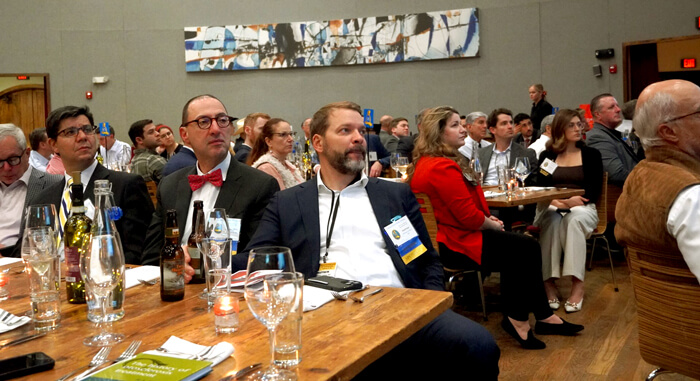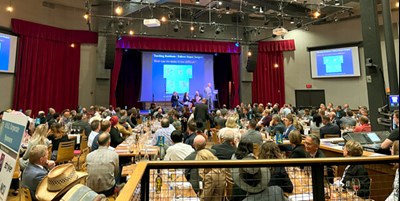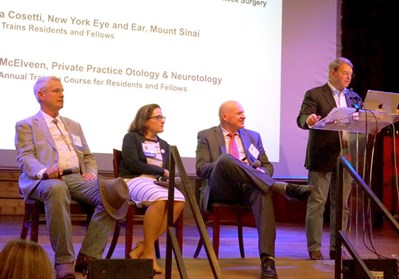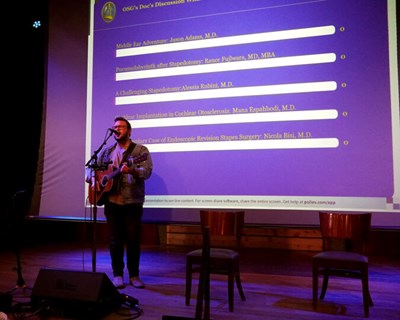
 John T McElveen, Jr, MD, Carolina Ear & Hearing Clinic, Carolina Ear Research Institute.
John T McElveen, Jr, MD, Carolina Ear & Hearing Clinic, Carolina Ear Research Institute.
The meeting was presided over by this year’s president, Dr Bruce Gantz from Iowa. In keeping with Nashville’s country-and-western roots, dress pants were replaced with blue jeans, ties with bolos, and dress shoes with cowboy/girl boots.
The scientific session included two didactic lectures. In Dr Alexander Claussen’s presentation, ‘Hearing rehabilitation in advanced otosclerosis,’ he discussed the advantages and disadvantages of stapedotomy versus cochlear implantation in patients with far-advanced otosclerosis. He said the majority of these stapedotomy patients receive serviceable hearing (>50% word recognition score (WRS)) and a smaller subset achieve excellent hearing (>80% WRS). In addition, prior stapedectomy did not impact cochlear implant outcomes. However, at his institution (Iowa) a cochlear implant is performed if the patient has no detectable WRS. When implanting these patients, the surgeon should be prepared to avoid “false tract insertion”, to drill out an obstructed cochlea and to deal with facial nerve stimulation during implant activation.
 The second didactic lecture was ‘Advanced otosclerosis: challenges in cochlear implantation’ by Dr Alicia Quesnel, who is the director of the Massachusetts Eye and Ear Otopathology Laboratory. She correlated the clinical symptoms of patients with far-advanced otosclerosis with their histopathology. She was able to able to explain the etiology of the sensorineural loss associated with otosclerosis by showing the hyalinisation of the spiral ligament when the otosclerotic focus breaches the endosteal layer of the cochlea. Additional histologic sections showed round window obliteration, intra-cochlear otosclerosis, peri-cochlear cavitations and otosclerotic foci adjacent to the labyrinthine portion of the facial nerve. The histologic sections correlated with the clinical concerns previously addressed in Dr Claussen’s presentation.
The second didactic lecture was ‘Advanced otosclerosis: challenges in cochlear implantation’ by Dr Alicia Quesnel, who is the director of the Massachusetts Eye and Ear Otopathology Laboratory. She correlated the clinical symptoms of patients with far-advanced otosclerosis with their histopathology. She was able to able to explain the etiology of the sensorineural loss associated with otosclerosis by showing the hyalinisation of the spiral ligament when the otosclerotic focus breaches the endosteal layer of the cochlea. Additional histologic sections showed round window obliteration, intra-cochlear otosclerosis, peri-cochlear cavitations and otosclerotic foci adjacent to the labyrinthine portion of the facial nerve. The histologic sections correlated with the clinical concerns previously addressed in Dr Claussen’s presentation.
 There was also a panel discussion on ‘Teaching stapes surgery: residents/fellows,’ moderated by Bruce Gantz, with panellists, Marlan Hansen, Maura Cosetti, and John McElveen. The panel pointed out the paucity of stapes cases for residents and fellows. This may necessitate directing these cases to residents/fellows who have a strong interest in otology. Currently, stapes surgery is grouped with other ossicular chain reconstructions. This allows the resident to satisfy board requirements without performing stapes surgery.
There was also a panel discussion on ‘Teaching stapes surgery: residents/fellows,’ moderated by Bruce Gantz, with panellists, Marlan Hansen, Maura Cosetti, and John McElveen. The panel pointed out the paucity of stapes cases for residents and fellows. This may necessitate directing these cases to residents/fellows who have a strong interest in otology. Currently, stapes surgery is grouped with other ossicular chain reconstructions. This allows the resident to satisfy board requirements without performing stapes surgery.
There were six entries for the OSG Doc’s Discussion Competition and the winner, based on live-stream polling, was ‘Middle ear adventure’ by Jason Adams. In his presentation, he used endoscopic videos to document the management of a patient who was explored for possible otosclerosis. Intraoperatively, the stapes appeared to be mobile, but the malleus was fixed by an ossified anterior malleolar ligament. In attempting to mobilise the malleus, the malleolar-incudal joint was disrupted. They used bone cement to reconstruct the joint. The patient had an excellent hearing outcome.
The audience found it refreshing to have a surgeon openly discuss his complication and its management. Dr Adams’s ‘Middle Ear Adventure’ had a happy ending: the patient closed their air-bone gap and Dr Adams received a $300 Amazon gift card, courtesy of Iridex lasers. Dr Virk, a well-known stapes surgeon in India, gave an outstanding case presentation, but did not want to compete against the neurotology fellows for the gift card.
 Nine new members were inducted into the society. Each was presented with a unique coffee mug depicting five pioneers of stapes surgery. The pioneers included Johannes Kessel, Joseph Toynbee, Maurice Sourdille, Julius Lembert and John Shea. Beneath each pioneer was a QR code that brought each of the historic figures to life. The AI-produced animations were the result of a collaboration between John McElveen, an otologist in Raleigh, NC, and his good friend, Michael Schröckenfuchs, an ENT surgeon in Mödling, Austria.
Nine new members were inducted into the society. Each was presented with a unique coffee mug depicting five pioneers of stapes surgery. The pioneers included Johannes Kessel, Joseph Toynbee, Maurice Sourdille, Julius Lembert and John Shea. Beneath each pioneer was a QR code that brought each of the historic figures to life. The AI-produced animations were the result of a collaboration between John McElveen, an otologist in Raleigh, NC, and his good friend, Michael Schröckenfuchs, an ENT surgeon in Mödling, Austria.
Liz Toh, the new OSG President, has already begun planning the next meeting in Miami. It will take place on 27 September 2024, a Friday evening rather than the usual Saturday, due to the Academy of Otolaryngology changing its start date to Saturday. Lastly, the OSG is accepting international applicants. Applications can be submitted on the Otosclerosis Study Group website.
Report from AAO-HNSF 2023 Annual Meeting & OTO Experience here.



